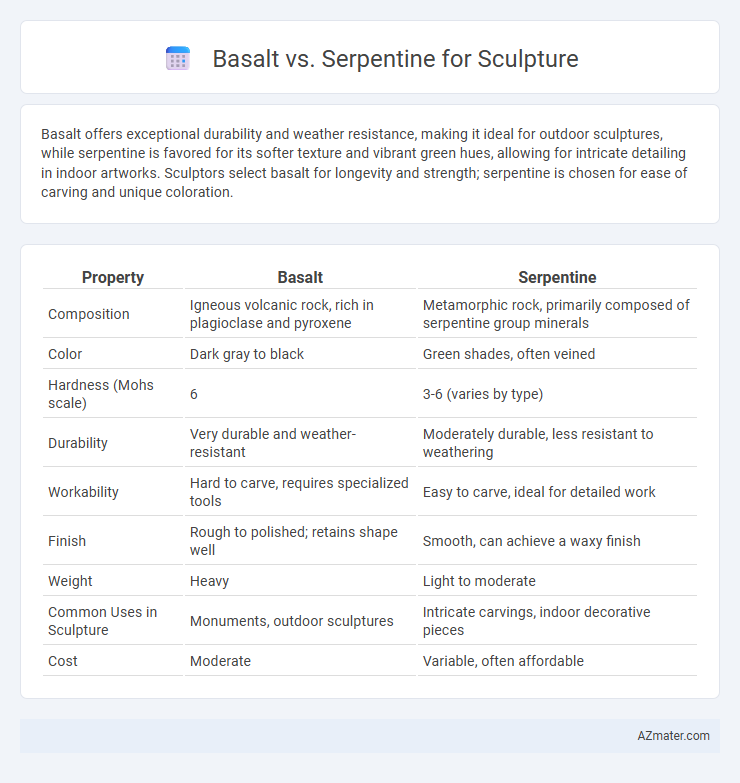Basalt offers exceptional durability and weather resistance, making it ideal for outdoor sculptures, while serpentine is favored for its softer texture and vibrant green hues, allowing for intricate detailing in indoor artworks. Sculptors select basalt for longevity and strength; serpentine is chosen for ease of carving and unique coloration.
Table of Comparison
| Property | Basalt | Serpentine |
|---|---|---|
| Composition | Igneous volcanic rock, rich in plagioclase and pyroxene | Metamorphic rock, primarily composed of serpentine group minerals |
| Color | Dark gray to black | Green shades, often veined |
| Hardness (Mohs scale) | 6 | 3-6 (varies by type) |
| Durability | Very durable and weather-resistant | Moderately durable, less resistant to weathering |
| Workability | Hard to carve, requires specialized tools | Easy to carve, ideal for detailed work |
| Finish | Rough to polished; retains shape well | Smooth, can achieve a waxy finish |
| Weight | Heavy | Light to moderate |
| Common Uses in Sculpture | Monuments, outdoor sculptures | Intricate carvings, indoor decorative pieces |
| Cost | Moderate | Variable, often affordable |
Introduction to Basalt and Serpentine in Sculpture
Basalt, a dense volcanic rock with a fine-grained texture, offers exceptional durability and dark, rich tones ideal for detailed sculptural work. Serpentine, a softer, greenish metamorphic rock, is prized for its smooth texture and ease of carving, making it popular among sculptors seeking intricate designs. Both materials present unique aesthetic and physical properties that influence artistic expression and longevity in sculpture.
Geological Origins and Formation
Basalt forms from rapid cooling of lava at the Earth's surface, characterized by fine-grained igneous texture ideal for detailed sculpting. Serpentine originates from ultramafic rocks undergoing hydrothermal alteration, resulting in a softer, often veined metamorphic stone favored for smooth, intricate carvings. The geological origins influence their hardness, texture, and weather resistance, affecting their suitability and durability in sculpture.
Physical Properties and Texture Comparison
Basalt exhibits a fine-grained, dense texture with high hardness and excellent durability, making it ideal for detailed and long-lasting sculptures. Serpentine features a softer, smoother surface with a waxy or greasy feel that allows for easier carving but less resistance to weathering compared to basalt. The contrast in hardness and texture between basalt's rugged, coarse structure and serpentine's polished sheen significantly influences their sculptural applications and finishing techniques.
Color Variations and Aesthetic Appeal
Basalt offers a rich palette of dark grays and blacks with subtle mottling, providing a sleek, modern aesthetic favored for contemporary sculptures. Serpentine displays a diverse range of greens, from deep olive to vibrant lime, often with intricate veining that enhances its organic and dynamic appeal. The color variations in serpentine create a uniquely textured look, while basalt's uniformity lends sculptures a bold, minimalist character.
Workability and Sculpting Techniques
Basalt offers high durability and fine-grain texture, making it ideal for detailed carving using chisels, pneumatic tools, and polishing for smooth finishes, but it requires significant effort due to its hardness. Serpentine is softer and more workable, allowing sculptors to use hand tools like rasps, files, and rotary tools to achieve intricate details and smooth surfaces with less physical strain. Both stones respond well to polishing, yet serpentine's lower density facilitates quicker shaping, while basalt's toughness delivers enduring sculptures resistant to weathering.
Durability and Weather Resistance
Basalt exhibits exceptional durability and weather resistance, making it ideal for outdoor sculptures exposed to harsh environmental conditions. Serpentine, while valued for its softer texture and ease of carving, is more susceptible to weathering and erosion, which may limit its longevity in exterior applications. Sculptors prioritizing long-term resilience tend to prefer basalt for its hardness and resistance to chemical and physical weathering.
Cost and Availability for Artists
Basalt, a dense volcanic rock, is moderately priced and widely available, making it a popular choice for sculptors seeking durability and ease of carving. Serpentine, softer and often prized for its layered colors, tends to be more expensive and less abundant, limiting accessibility for many artists. Cost-effective sourcing and regional availability heavily influence choice, with basalt offering a more practical solution for budget-conscious sculptors without sacrificing quality.
Historical and Cultural Significance
Basalt, prized for its durability and deep black hue, has been used since ancient civilizations like the Egyptians and Mayans to create statues symbolizing strength and immortality. Serpentine, with its rich green tones and relatively softer texture, was favored by indigenous cultures such as the Maori of New Zealand for carving intricate totems and sacred objects representing spirituality and connection to nature. The contrasting use of basalt and serpentine in sculpture highlights diverse cultural values and artistic techniques shaped by available materials and regional beliefs.
Ideal Artistic Applications
Basalt offers exceptional durability and fine-grained texture, making it ideal for detailed outdoor sculptures requiring weather resistance and structural strength. Serpentine's softer composition and distinctive green hues suit intricate indoor carvings and abstract art that emphasize color variation and smooth finishes. Choosing basalt enhances longevity and sharp definition, while serpentine enables more expressive, tactile creativity in sculptural art.
Choosing Between Basalt and Serpentine: Key Considerations
Basalt and serpentine differ significantly in hardness, texture, and workability, making these factors critical when selecting a material for sculpture. Basalt offers durability and a fine-grained, dark appearance ideal for outdoor or large-scale pieces, while serpentine provides a softer, smoother surface with rich green hues suited for detailed, polished indoor sculptures. Sculptors must weigh the required finish, durability, and carving complexity to determine the best choice for their artistic vision and project environment.

Infographic: Basalt vs Serpentine for Sculpture
 azmater.com
azmater.com